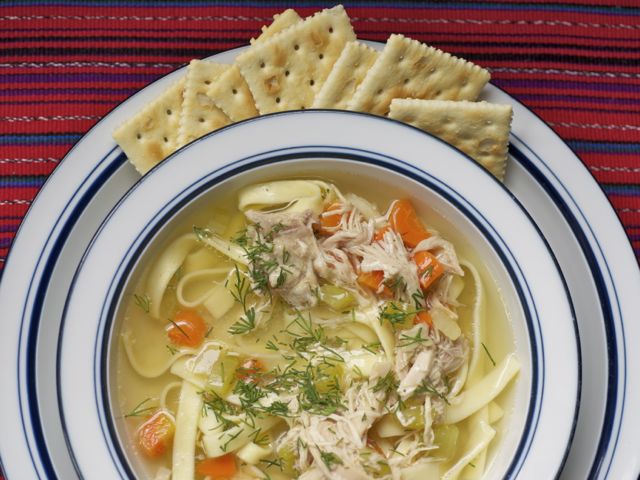
primary-image, l
(recipe, Lisa Schroeder & Danielle Centoni)

primary-image, l
Introduction
If I were to choose one dish that is a quintessential motherly dish, it's chicken soup. It's perfect any time — winter, spring, summer, or fall, whether you're feeling under the weather or not. It’s a complete meal in a bowl that’s nutritious and restorative — not to mention low-fat (when the fat is skimmed) and delicious. Chicken soup keeps for days, freezes well, and the boiled chicken can be used for countless other dishes. Chicken soup is one of the easiest recipes to make. It takes no more than half an hour to prepare, and cooks on its own for a few hours while you go about your life (or are busy teaching your kids!). Whenever my daughter Stephanie got sick, we had our routine: First stop was the doctor, then to the pharmacy to get the prescribed medicine, and finally to the supermarket to pick up the ingredients for this soup. Once home, the soup was simmering on the stove within 15 minutes.
Ingredients
Steps
Note
The longer a stock or broth cooks, the larger the vegetables used to flavor them can be. For example, vegetables used to flavor a veal stock can be cut larger than those for a chicken stock, because veal stock cooks longer (ideally overnight), and there is more time to extract the vegetables' flavors. In the case of chicken soup, I don’t even cut the vegetables because that’s the way my mother did it, and it saves time, too. But if it makes it easier to fit everything in the pot, feel free to cut the veggies in half. Working in a four-star restaurant can be very stressful because everything must be done to perfection. As entremetier at Le Cirque, my job was to cook the vegetables that went with most of the entrées served. It was imperative to know the exact moment something was done. I did this with my favorite tool: a thin, two-pronged fork. It had long, narrow tines that allowed me to pierce the cooking vegetables without leaving a trace. I still use it to this day. When vegetables offer no resistance, I know they are cooked to perfection and stop the cooking immediately or they overcook. If the tines of the fork don’t slide in and out easily, the vegetables are not done and need to be cooked some more. Variation: Italian Stracciatella. Instead of serving this soup with noodles, you can stir in beaten eggs, Parmesan, and spinach for an entirely different and classically Italian soup. Omit the diced carrots and celery and bring the strained broth to a simmer. Meanwhile, beat 3 eggs with ¼ cup grated Parmesan cheese and a pinch of ground nutmeg. Pour the egg mixture into the gently simmering soup in a slow steady stream, going from one side of the pot to the other and back again in a zigzag motion. Allow the eggs to cook for 1 minute without stirring. Gently run a long-handled spoon through the eggs to break them up a little. Stir in 1 cup baby spinach leaves, taste, and add more salt and pepper if desired. Serve with a loaf of crusty bread.